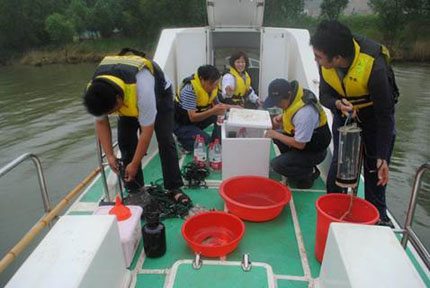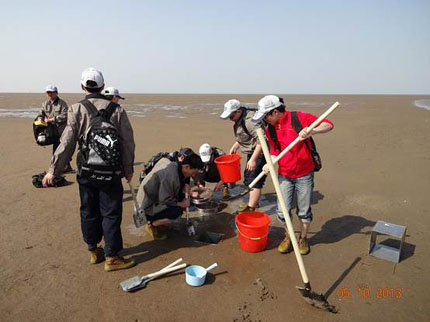Yellow River (Yangtze River) is the ‘mother river’ of China. It has a wide basin area and rich aquatic biological resources. The river has 191 recorded species (subspecies) of fish, while 114 of them are recorded for its estuary and surrounding areas. However, with the rapid social economic development along the Yellow River, the composition of fisheries resources has undergone a great change; major commercially important fishes were replaced by low-value small-sized fish species, while the major economic fisheries resources declined or even disappeared. Heavy losses were incurred upon the fishery economy. In this context, research project ‘Research and demonstration of the evaluation and the conservation techniques for fishery resource in the Yellow River and its estuary’ was the Public Welfare Industry (Agriculture) Scientific Programme. This project is coordinated by YSFRI researcher, Prof. WANG Jun, and it involves six research institutes. The project focus on the middle and lower reaches of the river and its estuary, by evaluating the quality and biodiversity of the fishery resources; developing conservation techniques for fish spawning area and migration channels; screening for habitat specific / resource declining candidate species for enhancement, and formulating the operation rules for resource enhancement; establishing the technology for enhancement capacity assessment and result evaluation; and setting up high efficiency fishery resource production and demonstration for different type of ecosystems.
Since its launch in 2013, the project has made a series of achievements, including:
1) It was found during the year-round survey that, there are 55 fish species in the Yellow River Shaanxi section, 43 species in the Henan section, 86 species in the Shandong section and 51 species in the estuary and its surrounding waters. Compared to the historical survey data, the number of fish species declined in all these areas;
2) Based on the main stream of Yellow River, we have surveyed the water quality parameters, phytoplankton and zooplankton distribution patterns, and the location of spawning areas for fishes;

3) It was found that the fish species composition in Yellow River estuary and its adjacent waters varied significantly in the summer. Chaeturichthys stigmatias, Clupanodon punctatus, Cynoglossus joyneri and Engraulis japonica were the main species in these water areas. The main environmental factors affecting the spatial distribution of fish assemblage in summer were salinity, depth and bottom water temperature. Fish community structure was affected by the combined effects of a variety of environmental factors.
4) DIN, salinity, SiO3-Si and As were the dominating factors affecting the water quality in the Yellow River estuary and its adjacent waters. The pollution was more serious in the Yellow River estuary than in its adjacent waters, and the pollution in the southern area was more serious than that in the northern area.
5) Both released and wild Chinese mitten crab from the Yellow River Delta exhibited high genetic diversity and no significant differentiation was detected between them. Compared with Chinese mitten crab from other waters, individuals from the Yellow River Delta also showed high genetic diversity.
6) Based on the trawl data in in Laizhou Bay, in August 2009 and 2013, it was found that the fishery resources was declining and the dominant species changed significantly. The community structure of fishery resources also changed.

7) Basic study on fishery resource enhancement in Laizhou Bay showed that the food rank of phytoplankton was V (very rich) and macrobenthic animals was IV (rich) respectively in releasing times according to recent surveys. The food organism density ofPenaeus chinensis was the highest in the Northeast (May) and the Middle East (June). The density of predator of P. chinensis was the highest in the Middle West (May) and the Southeast (June) respectively of Laizhou Bay.The food organism density of P. trituberculatus was the highest in the Southwest and the Northeast (May and June). The density of predators for P. trituberculatus was the highest in the Middle West (May) and the Northwest (June) respectively in Laizhou Bay.
8)Based on the Ecopath model, the energy flow mainly concentrated on trophic level I-III in Yellow River estuary and adjacent waters, and was relatively less in trophic level IV or above. During a survey in August, the primary assessment of carrying capacity of swimming crab was 1.5115 t·km?2 in Yellow River estuary and adjacent waters.
